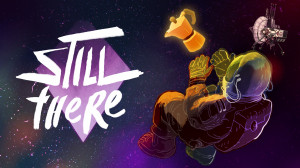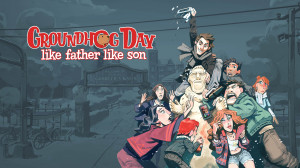Review for Demons Never Lie

Don’t be fooled by the cheery voxel art style of Demons Never Lie, which belies the game’s macabre tone. And though its blend of horror, comedy, and drama makes for a fantastical story, it also manages to be relatable and grounded. With a great hook and smart pacing, this is a satisfying and engaging adventure from the first scene all the way through to the last, with IndieBug’s love for their work shining through in every single aspect of production. Though its puzzles won’t test your brain power to any notable degree, what it lacks in challenge it makes up in charm.
The plot in Demons Never Lie is a comedy of intertwining narratives. It begins with a man named John watching his own funeral from the afterlife. Understandably saddened, John is especially dismayed by the absence of a certain woman. Soon he is greeted by a young girl named Alba. After a short conversation, John is granted a final few minutes in the funeral home (acting as a short tutorial) before Alba is to lead him away. Gazing upon his corpse once more, John’s reflection is cut short by the sudden appearance of Ocaso. Ocaso offers John an alternative course: return to the world of the living as a young man and fix his past mistakes – for a price. John doesn’t take much convincing, and he promptly signs ownership of his soul over to Ocaso.
Waking up in his 28-year-old med school dropout, money mooching, drunk driving, wife-stealing, rich kid body, John hops right back to his privileged daily routine. Turns out, John is kind of a jerk. He’s not an antihero, dominating others to reach the top, nor is he a sociopath, doing horrible things merely for the pleasure of it. John is simply misguided, and kind of dumb. In the opening minutes of Chapter 1, John steals his mother’s credit card, fakes a prescription, and prods his girlfriend, Lucia, to leave her husband Mark for him. But with some not-so-divine intervention from Ocaso, John comes to realize the error of his ways – kind of.
John uncovers a plot involving his father that threatens to tear his family apart, which assumedly he knew nothing about during his (first) life. Though he manages to thwart it this time around, victory is short-lived and his story quickly resumes its tragic trajectory. When the first chapter comes to a close, one wonders if John has signed his soul away for no reason, his fate written no matter his desire for change.
Once again finding himself on the celestial plane, exactly how John’s re-life ended (or didn’t end, as the case may be) remains unclear. However, it appears his deal with Ocaso is not restricted to his own life, as he is granted yet another passage back to the world of the living. This time he inhabits the body of Peter, Lucia and Mark’s 14-year-old son.
In Chapter 2, we see how the tension of Peter’s parents' marriage affects his life, as well as the (literal) demons he lives with. Peter has a friend named Ketchup. Ketchup is an adorable teddy-bear-esque creature who wears a skull mask, its teeth stained with what Peter endearing refers to as ketchup. Unfortunately, he's also a demonic minion who, like Ocaso, has unclear motives. While Peter loves Ketchup’s company, he also has to frequently cover for his friend, whom only he can see.
After Ketchup does what Ketchup does and makes something of a mess in the attic, Peter is sent to a special school for psychiatric help. Here he meets a girl named Amelia, who, to Peter’s surprise, can see Ketchup too. The two form an instant bond, and Peter is willing to do just about anything to help Amelia, whose sister was killed by a serial killer named OJO – mentioned in passing in John’s chapter. She has become obsessed with finding a way to bring her sister back through supernatural methods, using the innate gifts she and Peter share. Assisting Amelia in her pursuit of the occult, events quickly take a turn for the worse and Peter’s chapter ends just as abruptly as John’s.
The reincarnation loop continues on into the third chapter, with John now reliving Mark’s life instead. At this point John is given the opportunity to not only gain perspective on the effects of his relationship with Lucia, but to save the family he had a part in breaking up. Mark’s chapter plays out over a considerably longer time frame than Peter and John’s, beginning with Mark investigating the OJO case. His overzealousness results in unintended consequences, unfortunately, and Mark spirals into a deep depression.
Playing as Mark is uncomfortable to say the least, as you are forced to lash out at his family. However, given the knowledge John (and the player by proxy) holds about future events, you are gradually able to steer Mark back on course, the climax of his story threading the loose ends of Peter and John’s chapters together.
Demons Don’t Lie ends up being an interesting character study. Though it’s easy to initially scoff at John when contrasted with Mark, Lucia, and even the supporting cast, you come to learn that the protagonist is not so alone in his blindness. All the characters act out of selfishness in some way, dismissing the feelings of others to justify their actions. While Peter is the most innocent of the bunch, we see even him wrestle with right and wrong, sacrifice and surrender.
While the player is given control over each character’s actions to a degree, slipping into John’s, Peter’s, and Mark’s shoes offers up drastically different experiences. It’s not hard to follow Mark or John’s logic given their situation, but actually performing the required tasks still feels wrong. It’s an immersive and effective technique, giving you a handicapped degree of control and insisting that you act within the confines of what your given avatar would choose, not what you would prefer.
Environments are broken into distinct scenes with fixed camera angles. If you click an exit even from the other side of a room, the game will quickly transition to the next area, not forcing you to wait for your character to actually walk the entire distance. Because the individual sets are fairly small, there is no need for arduous backtracking. However, in some interior areas (like John’s home) the camera is zoomed in quite close. One is only ever able to click a few paces ahead while the camera adjusts, making the process a bit tedious. Gamepad or keyboard support would have been nice, but it’s hardly a deal-breaker.
Mechanically, Demons Never Lie is straight-up point-and-click. Right-click dictates everything from interaction to movement, while left-click brings up your inventory. There isn’t a whole lot of pixel hunting (or rather, voxel hunting), with points of interaction clearly marked by the cursor. Some objects can be interacted with directly and others can be collected for later use. While there are multiple approaches to some scenarios, you’ll never find yourself overburdened with inventory. You’ll usually only be carrying a handful of items at a time, and their use is often immediate or well-telegraphed, such as John needing a card to get money from an ATM before meeting Lucia at a nearby park.
The solution to every puzzle is always nearby, and the game does not move you forward without ensuring you have all the items and information you require to proceed. Some puzzle setups are a bit confusing, though figuring out how to complete them is rarely a challenge. Early on, John finds the lightbulb in his father’s desk lamp is missing. Why is this important, especially seeing as sunlight fills the room? It’s never clear, but since you can interact with it, one gets the impression you probably should. In the same office, John needs a pen to forge the aforementioned prescription. There is a pen on the desk, but John can’t take it. Instead, he has to jump through hoops elsewhere in town in order to get a totally different pen. Again, the objective is clear, but the steps to achieve them are just a little silly.
The main focus here is narrative, however, not brain power. Demons Never Lie continually loads you up with fetch quests, but never to a degree where it stalls the storytelling. These micro-tasks are simply meant to keep you engaged, steering the game clear of visual novel territory.
Occasionally you will be prompted with multiple choices for dialogue and interaction. Individually, some of these simply alter a person’s reaction, but when added up they can have a drastic effect on the game’s outcome. In Chapter 1, Ocaso periodically snaps into existence to provide John with insight into the potential consequences of his action, but ultimately leaving the choice up to him. These bits are genuinely funny, and it’s hard not to follow his advice, wrong as it may feel. If John commits the required number of sins rather than attempting to do good, you’ll be able to unlock the game’s hidden ending. It may not be something you go for in a first playthrough, but the experience is entertaining enough to warrant a repeat run, doing (or avoiding) what you didn’t originally.
Along the way there are a few free-form drawing and writing bits strewn throughout. These scenarios offer up bits of comedy to lighten the mood just when it’s on the verge of becoming too grim. You won’t be penalized for a bad drawing or writing a note that makes no sense – nor, as far as I can tell, will you be praised for drawing/writing well. These scenarios are just for fun, goading you on to test an NPC’s reaction.
The voxel graphics jive well with the game’s flamboyant tone, the cartoonish retro vibe helping bolster what could have been a very depressing slog. You’ll spend most of the game in urban areas, though sections in the woods, crypts, and the afterlife showcase the beauty of grand, oblique geometry illuminated by spooky-coloured lighting. Excellent animation and strong cinematography keep things lively throughout, and character models possess a slew of lifelike animations. John’s mother, Wilma, is especially commanding on screen, her weighted and bouncy figure making the most of her voxel build. A dance scene with Peter and Ketchup jamming out in perfect choreography is another highlight. The game’s quirkiness ensures a bout of laughter is never far behind a scene of heartbreak, and watching characters react/interact with their surroundings is just as fun as reading the actual dialog.
Character portraits during conversation on the other hand are... inconsistent. While always recognizable even through the blocky design, the art style drifts between characters. Some adhere to a wide-eyed anime style, while others look a bit closer to an American cartoon. That’s not to say the drawings are badly done. Each character has a variety of portraits, nicely communicating their range of emotions. The different looks between them is distracting to switch between on the fly, however.
Characters in the first half of the game feel well-developed. Jimmy, John’s best friend, sounds and acts like the mid-‘20s douchebag he is. Likewise, his mother, housekeeper, and Ocaso make for a varied and colourful cast. And special praise should be given to how well Peter’s inner monologue is written (speaking from experience). In Mark’s chapter, on the other hand, the cast seems to lose a bit of identity. This could be partly due to him spending so much of his time around other police officers who all use a similar vocabulary. But even his wife, Lucia, lacks any real screen presence or personality, preventing you from empathizing with someone who actually has quite a large role in the plot. It feels like the script could have used a final once-over.
Music is relegated to a few tracks that loop throughout. Most of the urban areas feature catchy and fun instrumental bits, matching the visuals’ pop and energy. Even continually repeating as they do, scenes change up frequently enough to save it from becoming irritating. There is no voice acting, but sound effects (like Ketchup’s adorable chitter) are well done.
Demons Never Lie is a Kickstarter game, but you wouldn’t know it until roughly halfway through. Navigating backer content in-game is a tricky balance. You want to pay tribute to those who helped, but you don’t want to neglect the rest of your audience, making them feel left outside of a series of inside jokes. IndieBug opted to include a backers’ graveyard. Amelia proudly points it out to Peter, though actually going to look at the tombstones is up to you. It’s a non-invasive but thoughtful way to thank the community, and one of the smarter implementations I’ve seen in a crowdfunded game.
I encountered several glitches in my playthrough: characters occasionally clipped through furniture, and the cursor didn’t always switch back between the interact and default options, causing some minor confusion. I also somehow picked up an item once without having clicked on it. None of these had any lasting impact on gameplay, fortunately, but they’re worth highlighting nonetheless.
Demons Never Lie is a passion project, and it shows. I became seriously invested in John’s, Peter’s, and Mark’s lives during my 3½ hour playthrough and I would be lying if I said I didn’t shed a tear by the end. This is the type of game you come out of a different person on the other side, inspiring you to reflect on your own life, in no small part due to the way you become inextricably connected to the protagonists. You are given choices, but rarely (especially early on) are they good options. Though the gameplay is hardly complex, the moral dilemmas presented are more than enough to keep one engaged throughout. It could have used a bit more polish in some areas, but even with its few imperfections, Demons Never Lie stands as an impactful narrative adventure.

































